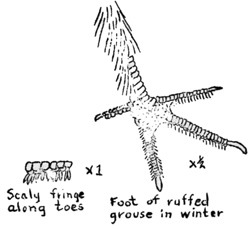

|
|
NATURE NOTES FROM ACADIA
What a wild quaint chatter constitutes the babble of the talkative Old Squaws! There is something about it reminiscent of the distant cry of migrating geese - something ancient, primitive - a conversation which is today what it probably was untold hundreds of thousands of years ago. Its freedom and wildness belong to the changeless open sea. 
In the gullet of a Ruffed Grouse, an individual which was brought to me in early March after having met death by flying into the street wires, I found a number of staminate aments of birch. It is largely due to the bird's ability to thrive on such fare that the grouse is very well able to withstand the rigors of the most severe winters. The warmth-retaining property of the heavy under-coat of soft silvery-gray feathers is another consideration in favor of the bird - I could not help but marvel at such an insulation, reminiscent of the feathering of an owl. Then too the bird's "snowshoes" are a factor - a double fringe of scales on each toe which aid the bird in bearing its weight on the snow. Not infrequently grouse spend the cold winter nights in the deep snowdrifts. Last winter, upon following a grouse which I had flushed and which settled again in a nearby stand of open woods I again startled the bird who took wing for a short distance and then disappeared from sight by deliberately diving into the deep snow. Along the carriage roads in and near Acadia National Park a careful observer may find depressions in the snow where lone birds had spent the night. The first chipmunk of the year was reported on March 19. Five days later three more of these winter sleepers were sighted. On March 22 the singing of song sparrows in Bar Harbor assurred me of the fact that the almanac was not at fault. Spring had come to Acadia. On the 25th the woodcock returned, and on the last day of March three wild geese were sighted flying low over Town Hill. By the end of March the pussy willows, with their spring promises wrapped in soft silvery-gray packets, become symbols of a season new-born. Alder and aspen catkins lengthen, soon to sow their golden dust on the wings of the wind. Hardy insects venture into the weak March sunlight, while such forms as centipedes, millepedes, pill-bugs, slugs, mites, and spiders are to be found more or less active in old well-rotted logs. The face of the fields may be dappled with the lingering snows of winter, but under the surface a myriad forms are awaiting the call of the warm spring winds. How eager we were to shed the icy fetters after experiencing one of the very coldest winters on record! When February, the Hunger Moon, gave way to March, the Awakening Moon, the aspect out-of-doors was a frigid one indeed, but by the end of March the snow blanket in the fields had sagged greatly while in the towns on Mount Desert Island almost all the snow had disappeared. On April 5, Mr. Vernon Lunt of Town Hill saw a garter snake in the big meadow at the east foot of Champlain Mountain, and three days later he collected 10 garter snakes in the same locality - all being within a small area circumscribed by lingering snow. Apparently the serpents had just left their hibernaculum. The first trailing arbutus was reported on April 13. A. S. |
| <<< Previous | > Cover < |
nature_notes/acad/vol3-2c.htm
09-Jan-2006